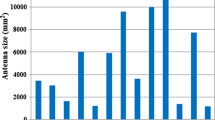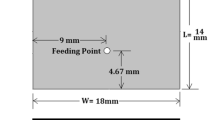Abstract
In this paper, we present a compact slotted microstrip patch antenna whose multiband characteristics have been studied. This antenna is compact in shape and size having a dimension of 24 × 24 mm2. This antenna consists of two inverted F-shaped slots in the patch and a defected ground plane for enhancement of impedance bandwidth. This patch is fed by a coaxial probe. The antenna shows multi band characteristics, i.e., from 1.94–1.98 GHz, 2.4–2.52 GHz, 3.2–3.38 GHz, 5.07–5.41 GHz, 5.73–6.09 GHz. After analyzing all necessary characteristics in perspective of gain, bandwidth, polarization, and return loss, the proposed patch is well applicable for WLAN (2.4/3.2/5.2/5.8 GHz) and WiMAX (5.5 GHz) communications.
Access provided by CONRICYT-eBooks. Download conference paper PDF
Similar content being viewed by others
Keywords
1 Introduction
The necessity of multiband antenna is increasing due to prevalent diversities in wireless standards of the modern communication system. Modern communication system requires compact, light-weight, low-profile antennas. For this reason, printed slot antennas find application in various wireless communications ranging from mobile phones to satellites. A number of slotted antennas with different geometry has been proposed for working in WLAN, WiMAX applications [1,2,3,4,5]. In [1], an UWB monopole antenna is studied for the response of different rectangular ground slot for multiband appliances. In [2] a small microstrip antenna consisting of two F-shaped slots radiators and a defected ground has been presented which shows three bands and covers entire WLAN and WiMAX frequency bands. In [3] a planar antenna with folded structure has been proposed which covers dual frequency band for WLAN (2.4/5 GHz). In [4] an upside-down F-shaped antenna with an U-shaped slot has been proposed which covers WLAN frequency bands. In [5], a compact antenna with inverted L-shaped slots has been proposed which covers the WiMAX bands. Several other multiband antennas have been proposed in [6,7,8,9,10]. Though these antennas are efficient in their respective domains, still there exists an issue regarding the compactness of the structure and complexity in feeding technique. Here, we have presented a compact slotted patch antenna with multiband characteristics. The antenna is compact in shape and size having a dimension of 24 × 24 mm2. The antenna primarily consists of two inverted F-shaped slots in the patch. The ground plane also defected for further enhancement the impedance bandwidth. The patch is fed by a coaxial probe. The antenna shows dual band characteristics, i.e., from 2.70–2.73 GHz and from 5.02–6.02 GHz. After that for getting multiband characteristics, we examine over the ground plane slots (explain in Sect. 4). After examining all necessary characteristics in perspective of gain, bandwidth, polarization, and return loss the proposed patch is well applicable for wireless communications. The antenna is stimulated and studied using Zeland IE3D software whose results have been discussed sequentially.
2 Antenna Design
In this paper, three different antennas have been designed and simulated. Initially, a simple microstrip patch has been designed, which has been subsequently followed by modifications in patch and ground plane. The geometrical structure of Antenna 1 (Reference Antenna) is shown in Fig. 1. The equation used for designing a microstrip patch for the fundamental mode is given as
where fr is the resonant frequency, c is the speed of light, εeff is the effective dielectric constant, which can be calculated using the formula:
where εr is the relative dielectric constant, L and W are the length and width of the patch, respectively, where h is the thickness of the substrate.
These two formulae are used to predict the substrate thickness and dielectric constant and resonant frequency point(s) of the antenna. Primarily, a Square Microstrip Antenna of patch width W = 20 mm and length L = 20 mm has been considered as Antenna 1 (Reference antenna) whose ground plane dimension is 34 × 34 mm2. The antenna has a FR4 epoxy substrate with 1.6 mm thickness and εr (relative permittivity) = 4.4, tan δ = 0.02. The feed point is located below the central portion of the proposed antenna patch. SMA connector of 0.4 mm internal radius provides the coaxial feed.
Figure 2 shows the modified patch which consists of a horizontal F-Shaped slot at the lower left arm and an identical inverted F-Shaped slot at the upper right arm. The dimensions have been provided in Table 1. Effect of inclusion of slots in the patch has been discussed in [6]. The patch is the main radiating element in microstrip patch antennas. Presence of slot(s) in patch disturbs the surface current distribution pattern (Fig. 8) of the antenna, thereby creating multiple resonant frequency modes.
Figure 3 shows the modified ground plane which consists of vertical rectangular stripes (dimensions provided in Table 1). This type of etched ground plane is known as a Defected Ground Structure (DGS). The effects of inclusion of DGS in antenna have been discussed in [7]. Defected Ground Structures help in minimizing the return loss of the antenna, thereby improving the realized antenna gain.
3 Results and Discussion
The Return Loss (S11) plot of Antenna 1, Antenna 2, and Antenna 3 have been depicted in Fig. 4.
On observation, it is seen that the simple microstrip patch (Antenna 1) shows three discrete frequency bands close to 3.5, 6.9, and 8.0 GHz. The antenna with the modified patch (Antenna 2) shows somewhat better return loss characteristics with resonant frequency shifted toward 6.0 GHz. On inclusion of DGS (Antenna 3) better frequency response characteristics have been observed. Two discrete frequency bands have been obtained. One ranging from 2.70 to 2.73 GHz and the other from 5.02 to 6.02 GHz. The latter is applicable for WLAN (5.2/5.8 GHz) and WiMAX (5.5 GHz) communications. The effect of slots in the ground plane, the gain and radiation characteristics of the antenna at these frequency bands have been discussed later along with necessary plots.
Figure 5 shows the substrate effect on return loss. The effect of putting slots in the ground plane has been depicted in Fig. 6. It has been analyzed that there has been an increment in impedance bandwidth as the no of rectangular slots in the ground plane has been increased to two. There has been an increment in impedance bandwidth when two rectangular slots have been introduced in the ground plane of the antenna. Multiple resonant modes are generated due to the inclusion of slot in the ground plane. Due to the presence of multiple slots these generated resonant modes come closer to each other, resulting in a wider bandwidth. Also an improvement in return loss characteristics of the antenna has been observed from Fig. 6.
Figure 7 shows the Gain versus frequency characteristics of Antenna 3. An average gain 1.3 dB has been observed at the frequencies of interest. The Radiation Pattern of the antenna has been depicted in Fig. 8. Well isolation has been observed between the co- and cross-polarized components at the frequencies of interest. The y-z copolar/x-polar and x-z copolar/x-polar radiation patterns have been depicted in Fig. 8.
4 Analysis of Ground Slot Gap
After verification of the ground slot gap (G) in Antenna 3 (Shown in Fig. 3), we can get more accurate result and perfect gain. By parametric study, the gap is considered to be 3.45 mm (which is considered as Antenna 4) for getting the desired multiband resonant frequencies which are shown in Fig. 9. It is found that Antenna 4 operate in 2.4, 3.2, 5.2, 5.5, 5.8 GHz (For IEEE 802.11 a WLAN Band).
5 Conclusion
The proposed antenna is compact in shape and size. The compact structure of the antenna makes it a suitable candidate which can be incorporated in wireless devices supporting multiband communication. Moreover, low-cost and the widely available FR4 epoxy substrate are used in this antenna design which makes it even more affordable. The antenna shows multiband band characteristics, i.e., from 1.94–1.98 GHz, 2.4–2.52 GHz, 3.2–3.38 GHz, 5.07–5.41 GHz, 5.73–6.09 GHz. After examining all the necessary characteristics in perspective of gain, bandwidth, polarization, and return loss the proposed antenna is well suitable for WLAN (2.4/3.2/5.2/5.8 GHz) and WiMAX (5.5 GHz) communications.
References
N. Kishore, A. Prakash, V.S. Tripathi “A multiband microstrip patch antenna with defected ground structure for its applications” Microwave And Optical Technology Letters, Vol. 58, No. 12, pp. 2787–3015, 2016.
A.K. Gautam, L. Kumar, B.K. Kanaujia, And K. Rambabu “Design Of Compact F-Shaped Slot Triple-Band Antenna For Wlan/Wimax Applications”, IEEE Transactions on Antennas And Propagation, Vol. 64, No. 3, pp. 1101–1105, 2016.
A.G. Alhaddad, R.A. Abd-Alhameed, D. Zhou, C.H. See, I.T.E. Elfergani, P.S. Excell, “Low Profile Dual-Band-Balanced Handset Antenna With Dual-Arm Structure For Wlan Application”, IET Microw. Antennas Propag., Vol. 5, Iss. 9, pp. 1045–1053, 2014.
P. Salonen, M. Keskilammi, And M. Kivikoski “Single-Feed Dual-Band Planar Inverted-Antenna With U-Shaped Slot”, IEEE Transactions On Antennas And Propagation, Vol. 48, No. 8, pp. 1262–1264, 2000.
Jui-Han Lu And Bing-Jhang Huang “Planar Compact Slot Antenna With Multi-Band Operation For Ieee 802.16 m Application”, IEEE Transactions On Antennas And Propagation, Vol. 61, No. 3, pp. 1411–1414, 2013.
B. Roy, A. Bhattacharya, A. K. Bhattacharjee and S. K. Chowdhury, “Effect Of Different Slots In A Design Of Microstrip Antennas,” IEEE International Conference On Electronics And Communication Systems, Coimbatore, pp. 386–390, 2015.
A. Bhattacharya, B. Roy, S. K. Chowdhury, A. K. Bhattacharjee; “A Compact Fractal Monopole Antenna With Defected Ground Structure For Wideband Communication”; Applied Computational Electromagnetics Society Express Journal, ISSN: 1054–4887, Vol. 1, No. 8, pp. 228–231, 2016.
Y. Z. Cai, H. C. Yang and L. Y. Cai, “Wideband Monopole Antenna With Three Band-Notched Characteristics,” in IEEE Antennas and Wireless Propagation Letters, vol. 13, no., pp. 607–610, 2014.
V. V. Reddy and N. V. S. N. Sarma, “Triband Circularly Polarized Koch Fractal Boundary Microstrip Antenna,” in IEEE Antennas and Wireless Propagation Letters, vol. 13, no., pp. 1057–1060, 2014.
P. S. Bakariya, S. Dwari, M. Sarkar and M. K. Mandal, “Proximity-Coupled Multiband Microstrip Antenna for Wireless Applications,” in IEEE Antennas and Wireless Propagation Letters, vol. 14, no., pp. 646–649, 2015.
Author information
Authors and Affiliations
Corresponding author
Editor information
Editors and Affiliations
Rights and permissions
Copyright information
© 2018 Springer Nature Singapore Pte Ltd.
About this paper
Cite this paper
Roy, B., Raja, G.A., Vasu, I., Chowdhury, S.K., Bhattacharjee, A.K. (2018). Compact Slotted Microstrip Patch Antenna with Multiband Characteristics for WLAN/WiMAX. In: Somani, A., Srivastava, S., Mundra, A., Rawat, S. (eds) Proceedings of First International Conference on Smart System, Innovations and Computing. Smart Innovation, Systems and Technologies, vol 79. Springer, Singapore. https://doi.org/10.1007/978-981-10-5828-8_29
Download citation
DOI: https://doi.org/10.1007/978-981-10-5828-8_29
Published:
Publisher Name: Springer, Singapore
Print ISBN: 978-981-10-5827-1
Online ISBN: 978-981-10-5828-8
eBook Packages: EngineeringEngineering (R0)













